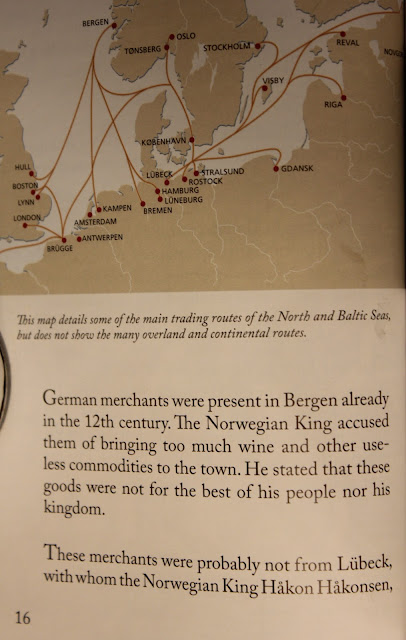(2005, by Geir Atle Ersland, Historian at the University of Bergen)
From page 21, "German merchants arrived in Bergen in increasingly larger numbers following the 1250 peace treaty with Lubeck. What was once short term stays during the summer months, became more permanent year round residences. Initially the merchants rented housing and storage rooms on Bryggen from the locals, but eventually they bought gards of their own. The Hanseatic population grew rapidly throughout the 14th century. By the middle of the 14th century the German merchants in Bergen organised themselves."

From page 63, "As early as the 13th century, the Norwegian King declared that all goods were to be exported through Bergen, even those originating from Iceland and Greenland. This is one of the reasons why the Hanseats were so successful in gaining control of the export from Bergen."
In other words, control of trade was pretty much in place by the mid-1300s, and I think the Hanseats were controlling trade to the extent that some Norsemen may have been swayed to look elsewhere for an avenue of trade...for instance, west of Vinland, to the far interior of America. But what, exactly, would be the benefit, or advantage, of securing furs etc. from America around the time of 1362? How would the furs be sold or otherwise disposed of, if not through Bergen?
What I'm trying to understand is where and how the advantage or opportunity would have come into play for the KRS-Norsemen. How would it help in dealing with the Hanse by developing a fur trade in Minnesota? In other words, how did the KRS party expect to realize profit for the American furs...did they expect to work with the Hanse somehow, or did they expect to work around them...and how?
I welcome commentary over this issue, as I want to better understand the possible motivations of the Kensington Runestone party for coming into Minnesota.
* Please note that I am a believer that there were two river-routes leading to the Kensington, Minnesota area back in 1362. One came in from the East Coast, the route through the Great Lakes, and the other came down from Hudson Bay, from the north. I believe it is no coincidence that the Kensington Runestone and many of the region's stoneholes--and some Norse petroglyphs and metal weapons, too--were found in this general area where the two river-routes come together. I believe the "merging spot" was recognized by medieval Norsemen early on as special, and special attention was given to it. They seem to have appreciated this fact of two waterways coming together, forming a great freshwater river highway CIRCLE, dipping right down into Mid-America--from one saltwater (oceanic) beginning to another saltwater (oceanic) beginning.
Are you Nordic and coming to Runestone Hill? You may take your pick of two routes in....



Comments
Post a Comment